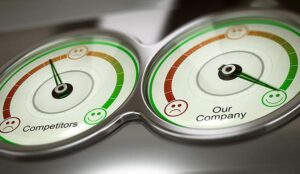Guy Letts of CustomerSure discusses why comparing your customer satisfaction scores with competitors is “pointless” and suggests what you can do instead.
Many of us are driven by the conviction that customer service drives business success.
We’re always looking for better ways to deliver, measure and improve customer satisfaction.
And there’s no shortage of tools, tips, techniques and methodologies (and their vendors) fighting for our attention.
But there’s a danger – it can feel like we haven’t finished until we’re doing all of them. Whereas in fact we should be considering each potential draw on our time and budget critically to see whether it adds value.
Because not every initiative packs the same punch and some of them pack no punch at all.
Benchmarking customer satisfaction is one initiative you can safely ignore. Don’t waste any time or money on it.
Benchmarking some things can be great. If my competitors deliver in one day and I deliver in two, that’s a hard customer benefit I can improve on. Or perhaps my competitor replies to enquiries within one hour and I only respond within a day. These are great things to benchmark because customers care about them.
But the question here is: ‘Can I benefit from knowing whether my competitors’ customer satisfaction scores are better or worse than mine?’
Some people can benefit – the people who sell the satisfaction benchmarking data benefit. But they’re the only ones.
Our company has the data, we have a ton of it because of what we do, but we won’t sell it.
It delivers no benefit, so it wouldn’t feel right.
Oh, it’s interesting, for sure. It’s absolutely fascinating. It just doesn’t help you.
Let’s look at the evidence.
1. It doesn’t benefit your customers
Actually it’s worse than that – it can alienate them.
When a company declares its ranking in the satisfaction league table, or even when a third party does, it infuriates each one of their customers who at that time is not having a good experience. Even an impressive 90% satisfaction rate means a 10% dissatisfaction rate.
It can be corrosive to culture within the company too. If you celebrate being top dog compared to competitors, you feel like you’ve won. But that attitude can appear complacent and insensitive to customers.
What’s much more important is how you measure up against the expectations of each of your customers, individually. When they’ve just had dealings with you; not some time later after all your survey data’s been collected and processed.
Consider the example of banks – a sector that traditionally receives low satisfaction ratings due to low incentives to provide great service (historically, customers tend to stay with their bank for life).
Banks make huge profits, and as such, it’s fair for their customers to have high expectations of service levels. But any bank benchmarking against its competitors’ satisfaction scores will be setting itself a target far, far lower than its customers would reasonably hope for.
The great customer experience champion Tom Peters sums it up brilliantly.
“How do you benefit by knowing that you’re no worse than anybody else?”
The bottom line – you win by beating your customers’ expectations, not by beating your competitors.
2. It doesn’t benefit your business
Not least because it doesn’t benefit your customers.
We like to measure things in terms of the ROI. I need to get a greater value in return than the cost of the time or money I am spending. Benchmarking satisfaction data does not yield a return.
To be fair, in eight years of me making this, case one person has suggested how a return can be achieved. They felt that satisfaction benchmarks would help them justify the value of their company to a potential purchaser. It’s a moot point – the business hasn’t sold yet – but even they did not claim that satisfaction benchmark data would improve their performance.
The problem with benchmarking satisfaction is that it doesn’t give me anything that’s actionable about my own customers. It might tell me I need to do something, but it doesn’t tell me what.
But if instead I ask my own customers instead I get the actionable data and I improve without the additional cost (and distraction) of the benchmarking data.
A senior executive in a snack food division of Pepsico once taught me, “If it doesn’t make our product taste better, or get the product faster and fresher to our customers, I don’t want you spending time on it.”
I have always found that advice, given 23 years ago, to be both refreshing and liberating, and I’m very grateful to her (even though it felt like a rebuke at the time).
3. The logic is flawed
On the surface it makes sense. If one company has a Net Promoter Score of 30 and the next has 35 then the comparison would seem to be straightforward.
But just because the two numbers are called the same thing does not mean they are comparable, because the data on which they are based can be subject to a high degree of circumstantial variation.
For the comparison to be valid, every facet of the satisfaction measurement process would have to be identical for both companies, and that’s highly unlikely. Not to mention the fact that statistically, even within the same company, the actual score is subject to a variation of plus or minus several points.
So even if two companies are both using the same methodology, whether NPS, or CSAT, or Customer Effort Score), you’re comparing apples with oranges.
The simplicity of a single number makes comparisons seductive, but unfortunately the mathematics makes any comparison unsafe.
What to do instead? Become the benchmark
Customer satisfaction is not primarily achieved through targets, measures and processes.
It’s about people and culture and values.
And the only important satisfaction benchmark is how you do against how each customer expects you to do. Not how you do on average.
To reduce it to statistics is to deny that customers are human beings, with emotions, preferences and a choice of where to spend their money.
And it’s to fly in the face of what every customer service professional knows – however good your systems and processes are supposed to be, something will go wrong on a regular basis and it’s how well you fix it that determines how a customer feels about you.

Guy Letts
So instead of measuring against your competitors, ignore them and measure how you’ve done against how a customer expected you to do, every time you deal with them.
Use the feedback to make sure you’re consistently faster, friendlier, easier to deal with and more knowledgeable than a customer expects.
That’s the best way to beat your competitors.
Author: Guy Letts
Published On: 21st Mar 2018 - Last modified: 10th Dec 2024
Read more about - Guest Blogs, CustomerSure, Guy Letts















